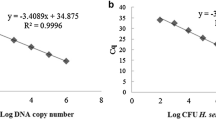Summary
Under controlled conditions in pots filled with sand, vermiculite and field soil, inoculation withA. brasilense-Cd ATCC 29729 or withAzotobacter chroococcum caused increases above controls in the weight and N content of panicles ofSetaria italica. In no case, however, did N increases in test plants exceed the initial total N content. High acetylene reduction activities (1,000–2,000 nmole/h/pot) could be found only in plants inoculated withAzospirillum. Inoculation withAzospirillum (strain-Cd) in the field caused a significant increase above noninoculated controls of 18.5% in shoot dry weight, ofSetaria italica. Azotobacter caused a non significant increase of 8%. No significant differences were found between yields ofSetaria italica grown in soil inoculated withA. chroococcum, and those of plants grown in the presence ofA. vinelandii. A. brasilense-Cd was more effective in the field thanA. brasilense Sp-7 ATCC 29145. The results suggest that Azospirillum may increase yields ofS. italica more efficiently than Azotobacter under local field conditions.
Similar content being viewed by others
References
Albrecht S L, Okon Y and Burris R H 1977 Effect of light and temperature on the association betweenZea mays andSpirillum lipoferum. Plant Physiol. 60, 528–531.
Berkum P van and Bohlool B B 1980 Evaluation of nitrogen fixation by bacteria in association with roots of tropical grasses. Microbiol. Rev. 44, 491–517.
Brown M E 1982In Bacteria and Plants. Eds. M E Rhodes-Roberts and F A Skinner. Academic Press, London, pp 25–41.
Cohen E, Okon Y, Kigel J, Nur I and Henis Y 1980 Increases in dry weight and total nitrogen content inZea mays andSetaria italica associated with nitrogen fixing Azospirillum spp. Plant Physiol. 66, 746–749.
Dart P J and Day J M 1975 Non-symbiotic nitrogen fixation in soil.In Soil Microbiology Ed. N Walker. Butterworths London pp. 225–252.
Hardy R W F, Burns R C and Holsten R D 1973 Applications of acetylene-ethylene assay for measurement of nitrogen fixation. Soil Biol. Biochem. 5, 47–81.
Hiller A, Plazin J and Von Slyke D D 1948 A study of condition kjeldahl determination of nitrogen in proteins. J. Biol. Chem. 176, 1401–1420.
Jensen H L 1965 Non-symbiotic nitrogen fixation. Agronomy 10, 436–480.
Kapulnik Y, Okon Y, Kigel J, Nur I and Henis Y 1981 Effects of temperature, nitrogen fertilization and plant age on nitrogen fixation bySetaria italica inoculated withAzospirillum brasilense (strain Cd). Plant Physiol. 68, 340–343.
Kapulnik Y, Sarig S, Nur I and Okon Y 1983 Effect ofAzospirillum inoculation on yield of field grown wheat. Can. J. Microbiol. 29, 895–944.
Kapulnik Y, Sarig S, Nur I, Okon Y, Kigel J and Henis Y 1981 Yield increases in summer cereal crops of Israeli fields inoculated with Azospirillum. Exp. Agric. 17, 179–187.
Lin W, Okon Y and Hardy R W F 1983 Enhanced mineral uptake byZea mays andSorghum bicolor roots inoculated withAzospirillum brasilense. Appl. Environ. Microbiol. 45, 1775–1779.
Nur I, Okon Y and Henis Y 1980 An increase in nitrogen content ofSetaria italica andZea mays inoculated with Azospirillum. Can. J. Microbiol. 26, 482–485.
Okon Y, 1984 Response of cereal and forage grasses to inoculation with N2-fixing bacteria.In Advances in Nitrogen Fixation Research. Eds. C Veeger and W E Newton. Martinus Nijhoff, Dr W. Junk/Pudoc Publishers The Hague. Wageningen. pp 303–309.
Okon Y, Albrecht S L and Burris R H 1977 Methods for growingSpirillum lipoferum and for counting it in pure culture and in association with plants. Appl. Environ. Microbiol. 33, 85–88.
Okon Y, Heytler P G and Hardy R W F 1983 N2 fixation byAzospirillum brasilense and its incorporation into hostSetaria italica. Appl. Environ. Microbiol. 46, 694–697.
Patriquin D G, Döbereiner J and Jain D K 1983 Sites and processes of association between diazotrophs and grasses. Can. J. Microbiol. 29, 900–915.
Sarig S, Kapulnik Y, Nur I and Okon Y 1984 Response of non-irrigatedSorghum bicolor toAzospirillum inoculation. Expl. Agric. 20, 59–66.
Tarrand J J, Krieg N R and Döbereiner J 1978 A taxonomic study of theSpirillum lipoferum group, with description of a new genusAzospirillum gen. nov. and two species,Azospirillum lipoferum (Beijerinck) comb. nov. andAzospirillum brasilense sp. nov. Can. J. Microbiol. 24, 967–980.
Watanabe F S and Olsen R S 1965 Test of an ascorbic method for determining phosphorus in water and NaHCO3 extracts from soil. Soil Sci. Soc. Am. Proc. 29, 677–678.
Author information
Authors and Affiliations
Rights and permissions
About this article
Cite this article
Yahalom, E., Kapulnik, Y. & Okon, Y. Response ofSetaria italica to inoculation withAzospirillum brasilense as compared toAzotobacter chroococcum . Plant Soil 82, 77–85 (1984). https://doi.org/10.1007/BF02220772
Received:
Revised:
Issue Date:
DOI: https://doi.org/10.1007/BF02220772




